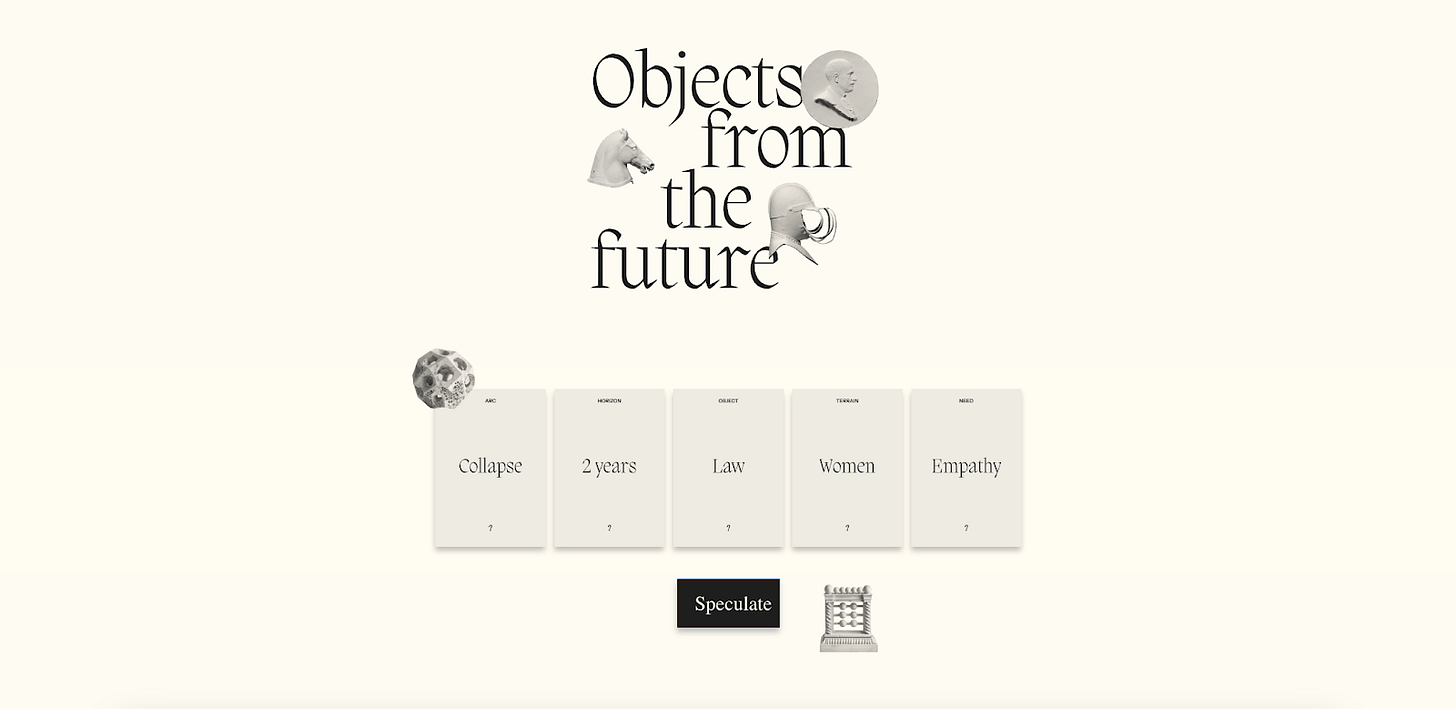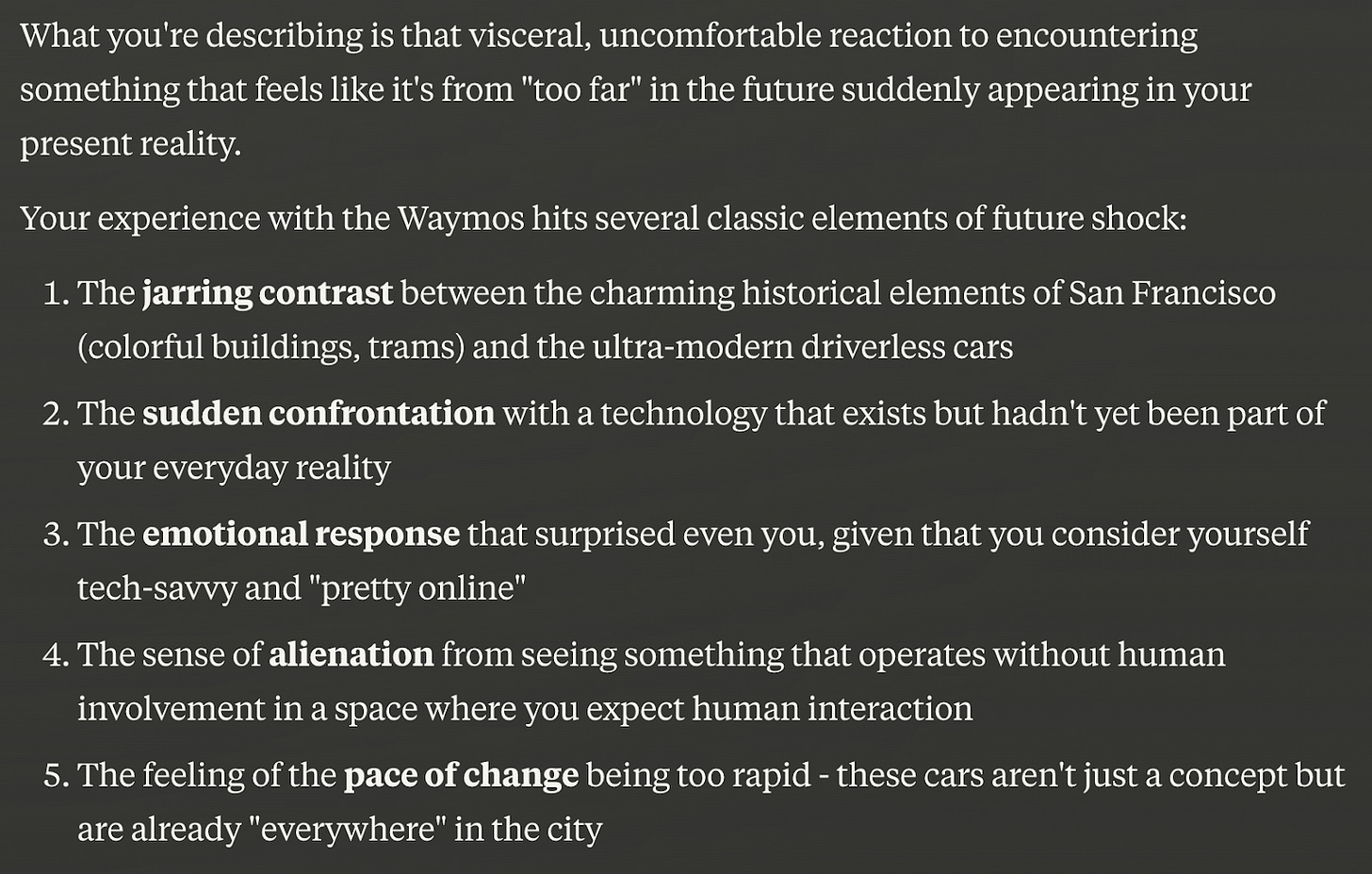A prompt generator for imagining the minutiae of the everyday in 2050 🔮
An experiment in making it easier to imagine the future.
Hey hello hi, it’s me, a distant delight from inboxes long past. We’re so back.
I’ve been thinking a lot about more collaborative ways to engage with culture and the future, beyond solo writing. This is an experiment! Get in my DMs if you wanna talk about it.
✨
TL;DR: I worked with design engineer Maxim McNair to create a tool that makes it easier to imagine the tangible elements of people’s lives in the future. Play with it here, and scroll to the end for some tips on how to use it.
I recently visited San Francisco for the first time. I was immediately charmed by the quaint, candy-colored buildings that rose high above the sidewalks, the softly rolling hills of the city’s expansive parks, and the old-timey trams that zoomed clumsily along their tracks, as though a totally normal and decade-appropriate mode of transport to be used in the US hub of modernity and innovation.
What I did not find to be so charming were the Waymos.
For those who haven’t encountered them, Waymos are basically Ubers, but driverless. Arriving minutes after they’ve been beckoned via app by their rider, these all-electric steeds cruise up to the sidewalk silently, driver’s seat conspicuously empty despite the presence of a steering wheel. Their promise is one of utmost convenience, no human intervention required. And they’re everywhere in San Francisco – the 300-strong fleet ran hundreds of thousands of rides in 2024, with the company announcing expansion into more than 10 new cities this year.
I’d consider myself a woman of the future. I’m pretty online. I use AI tools daily at work, and in my personal life. I’ve never had an issue with using an app to get… anything. But for whatever reason, these shimmering abominations struck a nerve. When I spoke to Claude about this, it told me that this was a great example of Alvin Toffler’s famed concept ‘Future Shock’:
Claude’s right – I do feel a sense of alienation when I see a Waymo. But the emergence, and subsequent success of, Waymos wasn’t willed into existence by VCs and entrepreneurs from nothing. They’re a symptom of the present day, born at the intersection of social, cultural and technological shifts that have been bubbling up over years.
The minutiae of our everyday – the services we use, the stuff we buy, the ways we choose to connect with friends or strangers – tell us a lot about current norms, and how our needs and values are changing or have already changed. They’re artefacts of social and cultural transformation.
Let me give you some more examples that aren’t as absurd as Waymo. I’ve intentionally chosen phenomena that are embedded in most people’s everyday lives (in the US, at least, where I live), but are still relatively new in the grand scheme of human history:
Vapes: They (somewhat ironically) wouldn’t exist without a rising prioritization of longevity, health and wellness, driving an emergent market that’s already worth more than $9 billion in the US alone.
Home offices: Working from home for those who are able is now expected among many US workers: 46% of those who currently work from home say they’d be likely to quit if they were asked to go back to the office full time. Home work spaces are not only an emblem of the decades-long growth of white collar jobs, but the blurring boundaries between personal and professional spheres.
Automated pet feeders: A recent study showed that more than 1 in 2 cat owners said the “worst thing” about feeding their pets wet food was “having to be present at meal times” (🤔). This POV, and the related product lines, wouldn’t exist without the normalization of dual-income households, and the rise of ‘busy-ness’ as an urban norm.
For someone 50 years ago who was trying to understand what our world today might look like, imagining artefacts like these would be a useful place to start: anchors in time, tracking the progress of larger shifts.
Imagining tangible elements of potential futures is a starting point for building out valuable context. And thinking about them is more important than we might think – especially at a time when every trendline we see rising from the treacherous terrain of the present day seems like a road to dystopia.
Why is it important to imagine objects from the future?
Research suggests that, despite the fact that our actions today can have very real implications on future lives, it’s more challenging to find empathy for people in the future vs. those in the present day (a phenomenon referred to as ‘intertemporal empathy decline’).
But there’s a plot twist.
When participants in the same study were asked to “vividly imagine another person's future suffering”, the value they placed on those future individuals’ well-being increased. Another study similarly suggested that thinking about the future of your own and others’ emotional wellbeing can increase feelings of “power and efficacy”.
In other words, imagining the future is good for the future.
By imagining tangible artefacts and objects, we can not only more effectively empathize with the people who live in these futures (including ourselves!), but potentially spur action to nurture and protect those futures.
So we created a tool for imagining what the details of the everyday might look like in a few years
We built a prompt generator for imagining tangible objects and artefacts from a near or far-flung future (find it here).
It’s an adaptation of The Thing From The Future: an award-winning card game created by Situation Lab (Stuart Candy, Ph.D. and Jeff Watson, Ph.D.) in 2014.
How it works
Click ‘Speculate’ to generate a creative prompt. Every prompt incorporates 5 variables:
Arc
What kind of future does this object exist in?
This element describes how society will have changed, intended to prevent us from falling into utopias or dystopias. There are 4 potential Arcs based on the work of Professor Jim Dator: Grow, Collapse, Discipline and Transform (described in more detail in the tool).Horizon
How far into the future will this object exist?
From 2 years to 200…Object
What is the object?
An item of clothing? A postcard? A map?Terrain
What context or industry does the object exist within?
Politics? Motherhood? Music? Fashion?Need
What human need will this object satisfy?These needs span the full` range of the hierarchy of needs: from thirst or shelter through to fulfillment or freedom.
Tips & tricks
💭 Avoid prescriptive play. If you don’t like one element of the prompt it generates, switch it out for something else!
✨ Hack it with AI. Conjuring something from nothing is hard. Sometimes if I need some fuel to get me started, I’ll feed the prompt to Chat GPT and then visualize using Midjourney.
❤️🔥 Speculate collaboratively. The tool was inspired by a game, and makes excellent stimulus for the hivemind. If anyone is interested in participating in an imagination workshop, lmk!
Futures to get you thinking
Everything’s better with examples. So here are a few to get you started, brought to life in collaboration with Claude and Midjourney…
In 2125, imagine…
Family Weave: clothing that enables true co-parenting
100 years from now, the Family Weave is considered an essential tool for parenting preparation. It’s a suit that uses haptic feedback and hormone simulators to mirror the pregnant person's experience – including fetal movements, back pressure, weight distribution, sleep disruptions, and even food cravings – and increase empathy and understanding in their partner.
Medical systems provide these suits as part of standard prenatal care, recognizing that shared physical understanding of pregnancy leads to more equitable postpartum care arrangements and stronger family bonds.
Arc: Discipline
Horizon: 100 years
Object: An item of clothing
Terrain: Motherhood
Need: Equity
In 2055, imagine…
HoloPal: a sustainable, affordable alternative to petcare
In 2050, HoloPal has become a popular alternative to traditional pet ownership for a growing cohort of people who cannot afford pets or don't have the space. The experience transitions seamlessly between full spatial computing at home and a mobile app for on-the-go companionship, and is especially popular among urban populations suffering with a decades-long loneliness epidemic.
Healthcare providers often prescribe HoloPal companions as part of therapy for loneliness, anxiety, and depression, with many insurers now covering ‘emotional support holograms’.
Arc: Grow
Horizon: 30 years
Object: Software
Terrain: Pets
Need: Connection
In 2040, imagine…
Coperni Cows: celebrity cows with a global audience
In 2040, cows are on the brink of extinction due to over-farming. French fashion brand Coperni has revolutionized luxury fashion through lab-grown leather derived from the DNA of a rare cohort of purebred cattle. People can select from an exclusive swatch collection to create custom, real cowhide goods without the need for slaughter.
The animals whose DNA underpins the collection live pampered lives in a French eco-lodge as part of Coperni's celebrated conservation effort. They’ve become global celebrities who participate in runway shows, walking alongside human models, and holding meet-and-greets with fans who travel from all over the world to see these sacred beasts in the flesh.
Arc: Collapse
Horizon: 15 years
Object: Public Figure
Terrain: Luxury
Need: Exclusivity
The current zeitgeist talks a big game about trends, but trends in their current form exist almost exclusively to service present-day commercial gains, rather than plan for the future – let alone drive the intent or action that could lead to a better one.
If anything, it seems like we’re doing less to build for the future. Governments are dropping climate commitments like they’re going out of style (they are), businesses are pushing to catalyze the development of AI by minimizing the safeguards that could protect people and society from the infinite potential harms, and the proportion of workers taking out pensions is declining in the US and Europe.
Could imagining the minutiae of the everyday 10, 50 or 100 years from now drive a desire for different outcomes? Would utopia reveal itself more quickly if we allocated more brain space to understanding the meals we’ll be sharing? The technologies we’ll use to feel less alone? Or the rituals we’ll use to connect with our pasts?
Science says… maybe? So Objects From the Future is an experiment in making these artefacts a little easier to visualize.
It’s probably not all gonna be bad. Right?







This is so so cool. Cant wait to have a play
So good, Lore! This might be up your street as well: https://futurerelics.berggruen.org